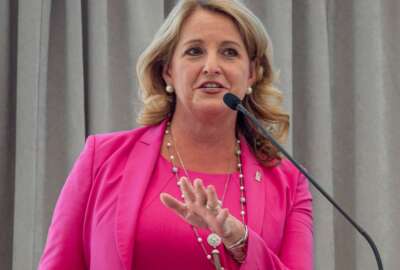

Chief information officers at two agencies that received higher overall marks on their FITARA scorecards this year have tole members of the House Oversight and ...
Chief information officers at two agencies that received higher overall marks on their FITARA scorecards this year, and a third CIO whose agency got an ‘A’ on data center closures, told members of the House Oversight and Reform Committee that efforts to move to the cloud have led to greater efficiencies and cost savings.
The Education Department, for example, has met its data center consolidation goal, and no longer has any on-site data centers. Education CIO Jason Gray told members of the oversight committee that the agency is in the middle of a “cloud consolidation,” which has allowed the agency to reduce data storage costs from $1.43 per gigabyte to 12 cents.
“There are savings to be had in data center consolidation and movement to the cloud,” subcommittee Chairman Gerry Connolly (Va.) said at the June 26 FITARA scorecard hearing. “I think you’re a poster child for doing that.”
Agriculture Department CIO Gary Washington said USDA is implementing a cloud portal within his office’s Digital Infrastructure Services Center, giving the agency an overview “for all things related to USDA cloud, including a Digital Services Catalog, real-time agency adoption statistics and workflow automation.”
The agency has enrolled 13 agencies into its USDA Cloud program, saving more than $12 million.
Through its Centers of Excellence initiative, USDA will reduce its inventory of data centers from 38 to two, and will streamline its 30 call centers down to one by the end of July.
For a governmentwide view on cloud performance, Federal CIO Suzette Kent said that within the first two years of the Trump administration, more than 1.8 million agency email mailboxes have moved to the cloud, increasing the governmentwide adoption of commercial cloud email from 45% to 72%.
At the Treasury Department, CIO Eric Olson said the agency is standing up a cloud-based talent management system that will serve as a common platform for employee training, performance management, and succession planning.
Olson said the department looks to maximize the percentage of resources spent on digital transformation in order to streamline its mission. Part of that effort, he said, includes enterprise-wide consolidation and greater use of shared services.
“We encourage our bureaus to focus on transforming mission outcomes by adopting practices from the private sector that have proven successful in delivering digital transformation, such as cloud-based services and agile development,” Olson said.
While the IRS has faced challenges with its legacy IT and the approximately 80-20 split between maintenance spending versus IT modernization spending, Olson said those conversations are on par with conversations he’s had with major private-sector financial institutions.
“I will just say as far as the IRS goes, and the big banks that I’ve talked to, this percentage, if you will, is not unlike with the biggest banks in the countries, as far as the split between run and build,” Olson said.
However, Connolly pushed back on some of the comparisons with the private sector, saying the IRS has faced “investment starvation” for nearly a decade that has prevented it from advancing its IT modernization goals.
“There is no private sector company I know of that has a 51-year-old operating system still operating and [is] dependent on,” Connolly said.
Subcommittee Ranking Member Mark Meadows (R-N.C.) expressed similar concerns with the state of the IRS’s legacy IT, as well as the antiquity of some of its programming languages.
“The thing for me is if we continue to spend operational money for COBOL and Fortran programmers and legacy system, it’s just mind-boggling that we would do it and we continue to do it,” Meadows said. “We’re having to pay a premium for the programmers because nobody programs in that language anymore.”
Gray said Education officials have been working to obtain language in the FY 2020 spending bill that would allow Education to create a working capital fund that would the agency to put away annual appropriations for longer-term IT modernization projects.
The Modernization Government Technology Act allowed for agencies to create these funds, but the legal teams at some agencies have said additional legislative fixes are needed to authorize the funds.
The Treasury Department doesn’t have an IT working fund set up, but Olson said the agency has met those goals through its revolving Treasury Franchise Fund.
“We have successfully used the Franchise Fund to pursue enterprise-wide services and to fund enterprise modernization priorities. We continue to explore how the flexibilities of an IT working capital fund could be beneficial to the department,” Olson said.
USDA moved an entire letter grade from last year’s scorecard. Much of that score improvement has to do with paring down the number of USDA CIOs from 22 to one. The agency now has eight assistant CIOs and a departmental administration assistant CIO.
But there’s still room for progress. Carol Harris, the director of IT management issues at the Government Accountability Office, said both USDA and Treasury would’ve earned a ‘B’ on the FITARA scorecard if their CIOs reported directly to their agency secretaries.
Washington said he meets regularly with both USDA Secretary Sonny Perdue and Deputy Secretary Stephen Censky, but Connolly said those authorities need to be reflected in the agency’s organization chart.
“It’s great you have access, but your successor may not,” Connolly said. “We want to institutionalize this in the formal structure of the organization.”
Copyright © 2024 Federal News Network. All rights reserved. This website is not intended for users located within the European Economic Area.
Jory Heckman is a reporter at Federal News Network covering U.S. Postal Service, IRS, big data and technology issues.
Follow @jheckmanWFED

